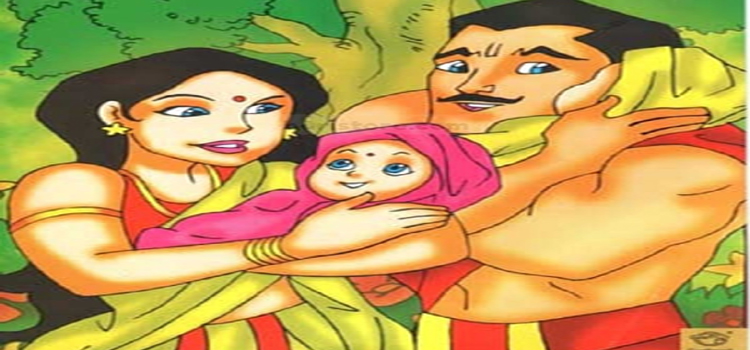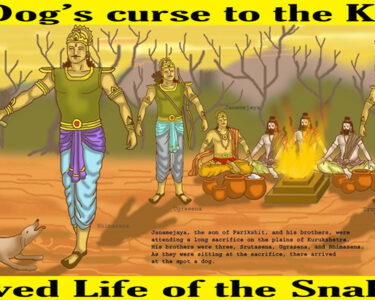“Vaishampaayana continued, “When king Vasu took his seat in that crystal chariot, with the gift of (Lord) Indra, and travelled through the sky, that Mahatma was approached by Gandharvas and Apsaras (the celestial singers and dancers). As he travelled through the upper regions, he was called Uparichara. By his capital flowed a river called Shuktimati. That river was once attacked by a life-endued mountain called Kolaahala maddened by Kaamaa. Vasu, seeing the foul attempt, struck the mountain with his foot. By the depression caused by Vasu’s foot, the river came out (of the embraces of Kolahala). But the mountain fathered on the river two children that were twins. The river, grateful to Vasu for his having set her free from Kolaahala’s embraces, gave them both to Vasu. The son was made the generalissimo (Senaapati in Sanskrit) to his forces by Vasu, that best of Rajarishi and giver of wealth and punisher of enemies. The daughter called Girikaa, was wedded by Vasu.
“Girikaa, the wife of Vasu, after her menstrual course, purifying herself by a bath, represented her state to her lord. But that very day the Pitris of Vasu came to that best of monarchs and foremost of wise men, and asked him to slay deer (for their Sraddha). The king (Vasu), thinking that the command of the Pitris should not be disobeyed, went on hunting thinking of Girikaa alone who was gifted with great beauty and like to another Sri (Goddess Lakshmi) herself. The season being the spring, the forest within which the king was roaming, had become delightful like to the gardens of the king of the Gandharvas (Kubera) himself. There were (trees like) Ashokaas (Botanical name is Saraca asoca), Champakaas (Botanical name is Magnolia champaca), Chootaas and Atimuktaas (Botanical name is Hiptage benghalensis) in abundance: and there were Punnaagaas (Botanical name is Calophyllum inophyllum), Karnikaaras (Botanical name is Cassia fistula), Bakulaas (Botanical name is Mimusops elengi), Divya Paatalaas, Paatalaas (Botanical name is Stereospermum chelonoides), Naarikelaas (Botanical name is Cocos nucifera), Chandanaas (Botanical name is Santalum album), Arjunas (Botanical name is Terminalia arjuna) and similar other beautiful and sacred trees glowing with fragrant flowers and sweet fruits.
“The whole forest was maddened by the sweet notes of the kokila (Zoological name is Eudynamys scolopaceus) and echoed with the hum of maddened bees. The king became possessed with Kaamaa, and he saw not his wife before him. Maddened by Kaamaa he was roaming here and there, when he saw a beautiful Ashoka (tree) decked with dense leaves, its branches covered with flowers. The king sat at his ease in the shade of that tree. Excited by the fragrance of the season and the charming odours of the flowers around, and excited also by the delicious breeze, the king (Vasu) could not keep his mind away from the thought of the beautiful Girikaa. Seeing that a swift hawk was resting very near to him, the king (Vasu), acquainted with the precise truths of Dharma and Arthaa, went to him and said, ‘Friendly one, you carry this seed (semen) for my wife Girikaa and give it to her. Her season has arrived.’
“The hawk, swift of speed, took it from the king and rapidly travelled through the air. While thus passing, the hawk was seen by another of his species. Thinking that the first one was carrying meat, the second one flew at him. The two fought with each other in the sky with their beaks. While they were fighting, the seed fell into the waters of the Yamuna. In those waters stayed an Apsara of the higher rank, known by the name of Aadrika, transformed by a Brahmana’s curse into a fish. As soon as Vasu’s seed fell into the water from the claws of the hawk, Aadrika rapidly approached and swallowed it at once. That fish was, some time after, caught by the fishermen. It was the tenth month of the fish’s having swallowed the seed. From the stomach of that fish came out a male and a female child of human form. The fishermen wondered much, and went to king Uparichara (for they were his subjects) told him all. They said, ‘O king, these two beings of human shape have been found in the body of a fish!’ The male child amongst the two was taken by Uparichara. That child afterwards became the Dharmic and truthful monarch – Matsya.
“After the birth of the twins, the Apsara (Aadrika) herself became freed from her curse. For she had been told before by the illustrious one (who had cursed her) that she would, while living in her fish form, give birth to two children of human shape and then would be freed from the curse. Then, according to these words, having given birth to the two children, and been killed by the fishermen, she left her fish-form and assumed her own Apsara shape. The Apsara then rose up on the path walked by the Siddhas, the Rishis and the Charanas.



